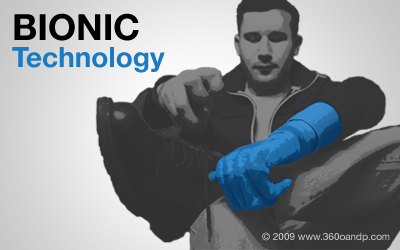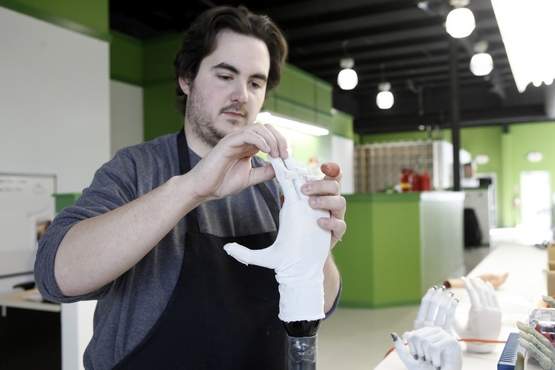
People tend to take a lot of things for granted.
For instance, take our hands. Every day, without thinking about it, we use them to grasp all kinds of objects. But suppose you didn't have an opposable thumb or were missing one or more fingers? Suppose you had no hand at all?
Accidents and diseases such as meningitis and diabetes result in 50,000 new amputations every year in the U.S., according to the National Center for Health Statistics. It's estimated that 41,000 people in the U.S. are missing a whole hand or arm. In fact, the most common upper-body amputations are partial-hand, where one or more fingers are missing.
So what happens when you can no longer take the use of your hands for granted?
There's help and hope, right here in the Hudson Valley. Middletown-based Prosthetic and Orthotic Associates is using revolutionary technology to assist people with missing hands or fingers.

Chris Caron of New Paltz secures padding to the finger joints of a protective glove over an i-Limb prosthetic hand at Touch Bionics in Newburgh. Times Herald-Record/CHET GORDON
Restoring the ability to grasp
P&O Associates fits people with an electronic prosthetic hand called i-Limb and electronic fingers known as ProDigits, both of which allow artificial replacement fingers to move independently of one another.
"A person with ProDigits or i-Limb may be able to grasp objects like a pen to write, or put on clothes, or even grasp a child's hand," said Tom Passero, president and clinical director of P&O Associates.
Passero, who lives in Sullivan County, is an American board-certified prosthetist (someone trained to replace missing human body parts). He sells a range of items to improve the quality of life for people missing limbs, and he passionately believes in those products.
"It's strange how the world operates," Passero said, explaining that in 1974 he was struck, while walking, by a drunken driver and lost his left leg below the knee. "The accident was a blessing in disguise, and I absolutely believe what I do is exactly what I was meant to do."
And now for the first time, Passero said, ProDigits makes it possible for people with partial hand amputation to have battery-operated fingers to grasp objects. There was no commercially available prosthesis that allowed active grasping for someone missing only fingers until Touch Bionics and the clinical team from P&O Associates launched ProDigits in December, Passero said.

Tying shoes, gripping a beverage, steering a vehicle: These everyday tasks, and many more, are possible for people missing fingers or hands, thanks to i-Limb prosthetics. Here, 23-year-old Michael Nye of Middletown demonstrates enhanced dexterity using his high-tech, electronic hand. Times Herald-Record/CHET GORDON
'I can tie my shoelaces'
Middletown resident Michael Nye, born without a left hand, uses the i-Limb hand. Previously, the 23-year-old's only option was an electronic prosthetic hand that moved the forefinger and index finger (and in some models, the middle finger as well) against the thumb in a pincerlike grasp.
"When I was little I wore what was essentially a plastic doll-like hand," Nye said. "Then I wore an electronic hand (pincer-grip type) through middle school. It was extremely limiting. In fact, my family and I nicknamed it 'the cookie-cutter,' because breaking a cookie was all it was good for."
In 2007, Nye was chosen to be a tester, and he was fitted for the i-Limb. Now several kinds of grips are available to him. Among these is a "power grip" that allows him to use the hand to create a full wrap around a glass or cup. And the index finger may be extended, to point. He also can do other things that weren't possible before.
"I can tie my shoelaces," he said. "I work for the Town of Wallkill Parks Department and do a lot of lifting. I'm able to pick things up, hold a broom, and I can even steer my vehicle with my i-Limb while I shift with my right hand."
ProDigits works pretty much by the same concept. The prosthetic hand is slipped over the remnant hand and remaining finger(s), much like a glove. Electronic movements are stimulated by any viable muscle remaining in the patient's hand or stump. No surgery is necessary, and putting it on is noninvasive. However, the person has to be trained to make the subtle muscle movements necessary to activate the tiny electronic sensors in the prosthetic fingers, so that each may do what it was designed to do.
This breakthrough technology was developed during the early 1960s in Scotland by a company called Touch Bionics. The company originally made prosthetic devices for children born with deformed limbs resulting from their mothers' use of the drug thalidomide. The company's technology evolved to make ProDigits in 1993 and brought the i-Limb to market in 2007.
Lifelike synthetic skin
When Touch Bionics began testing the devices, they functioned well, but lacked a pleasing aesthetic look. The synthetic-skin covering for the fingers and hands looked and felt rubbery.
Touch Bionics contacted Passero because, in addition to fitting people with all types of prosthetic hands, feet and knees, he created and marketed his own synthetic skin that looked real, felt real and matched the person's skin tone.
Touch Bionics bought the LivingSkin component of Passero's business, and now Passero has integrated ProDigits and i-Limb into his prosthetic and orthotic company, with offices in Middletown, Monticello, Kingston and Poughkeepsie.
As director of clinical communications for Touch Bionics, Passero travels around the world demonstrating ProDigits and i-Limb to doctors and hospital personnel. These products are unique to Touch Bionics, and the company has fitted about 60 partial-hand amputees with ProDigits and 1,000 full-hand amputees with i-Limb hands, Passero said.
Some young men like to wear their i-Limb hands without the LivingSkin, said Passero. He describes it as "The Terminator look." For Nye, going "skinless" is a matter of pride.
"I'm not ashamed for people to see my high-tech hand," he said. "I like the look. I was proud to be a tester, and I'm not going to hide the technology that has improved my life. And if people stare, let 'em."
Covered by insurance
The prosthetic devices, which charge up just as cell phones do, come with hefty price tags. ProDigits cost $30,000 apiece and the i-Limbs about $70,000. So far, Passero said, insurance companies realize how valuable the products are to patients and have paid for everything.
"I don't want to mislead people," Passero said. "You won't be able to punch an object with the i-Limb and make a huge impact (as did the fictional TV characters Bionic Woman and Six Million Dollar Man). You can't play the piano with it, either.
"But we have people working on it."
sscruggs@th-record.com